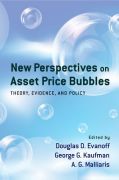
New perspectives on asset price bubbles
Evanoff, Douglas D.
Kaufman, George G.
Malliaris, A. G.
The realities of the recent financial crisis have intensified theoretical modeling, empirical methodologies, and debate on policy issues surrounding assetprice bubbles. Choosing to take a novel approach, the editors of this book have selected five classic papers that represent accepted thinking about asset bubbles prior to the financial crisis. They also include original papers challenging orthodox thinking and presenting new insights. A summary essay by the editors highlights the lessons learned and experiences gained since the crisis. This volume critically re-examines the profession's understanding of asset bubbles in light of the global financial crisis of 2007-09. It is well known thatbubbles have occurred in the past, with the October 1929 crash as the most demonstrative example. However, the remarkably well-behaved performance of the US economy from 1945 to 2006, and, in particular during the Great Moderation period of 1984 to 2006, assured the economics profession and monetary policymakers that asset bubbles could be effectively managed with little or no real economic impact. The recent financial crisis has now triggered a debate about the emergence of a sequence of repeated bubbles in the Nasdaq market, housing market, credit market and commodity markets. The Greenspan-Bernanke Federal Reserve has followed an asymmetric approach to bubble management. This method advocates no monetary policy action during the bubble formation and growth, but a speedy response with a reduction in market rates when a bubble bursts to reduce the potential loss of output and employment. It was supported by academic research and seemed to work well until September 2008 when the financial system came close to a complete collapse. INDICE: Introduction 1. New Perspectives on Asset Price Bubbles: An Overview Douglas D. Evanoff, George G. Kaufman and A.G. Malliaris Bubbles: Theory and Evidence 2. Churning Bubbles Franklin Allen and Gary Gorton. Seminal research paper: The Review of Economic Studies, Volume 60 (1993). 3. Rethinking Theoretical Models of Bubbles: Reflections Inspired by the Financial Crisis and the Allen and Gorton's Paper on Churning Bubbles Gadi Barlevy Consequences of Bubbles Bursting 4. The Japanese Banking Crisis: Where Did it Come From and How Will it End? Takeo Hoshi and Anil K. Kashyap. Seminal research paper: NBER Macroeconomics Annual 1999, vol 14 (2000). 5. The Impact of the International Financial Crisis on Asia and the Pacific: Highlighting Monetary Policy Challenges from an Asset Price Bubble Perspective Andrew Filardo Bubbles and Monetary Policy 6. Monetary Policy and Asset Price Volatility Ben Bernanke and Mark Gertler. Seminal research paper: Economic Review, Federal Reserve Bank of KansasCity (1999). 7. Monetary Policy and Asset price Volatility: Should We Refill the Bernanke-Gertler Prescription? Kenneth N. Kuttner Bubbles and Macroprudential Regulation 8. Towards a Macroprudential Framework for Financial Supervision and Regulation? http://www.bis.org/publ/work128.pdf Claudio Borio. Seminalresearch paper: CESifo Economic Studies, Volume 49 (2003). 9. Bank Liquidityand Bubbles: Why Central Banks Should Lean Against Liquidity Viral V. Acharyaand Hassan Naqvi Bubbles: Behavioral Explanations 10. Overconfidence and Speculative Bubbles Jose A. Scheinkman and Wei Xiong. Seminal research paper: Journal of Political Economy, Volume 111 (2003). 11. Asset Bubbles: Insights fromBehavioral Finance Werner De Bondt Bubbles: Keynote Presentations 12. An OldPerspective on Asset Price Bubbles Policy William Poole 13. Struggling to Escape From 'Assumption 14' Benjamin M. Friedman New Ideas on Asset Price Bubbles14. Monetary Policy and Stock Market Booms Lawrence J. Christiano, Cosmin Ilut, Roberto Motto, and Massimo Rostagno 15. Leverage and Bubbles: The Need to Manage the Leverage Cycle John Geanakoplos Asset Bubbles, Central Banks and Investments 16. Asset Price Bubbles and Central Bank Policies: The Crash of the Jackson Hole Consensus A. G. Malliaris 17. Do Bubbles Lead to Overinvestment? ARevealed Preference Approach Robert Chirinko and Huntley Schaller
- ISBN: 978-0-19-984433-3
- Editorial: Oxford University
- Encuadernacion: Cartoné
- Páginas: 464
- Fecha Publicación: 01/03/2012
- Nº Volúmenes: 1
- Idioma: Inglés
